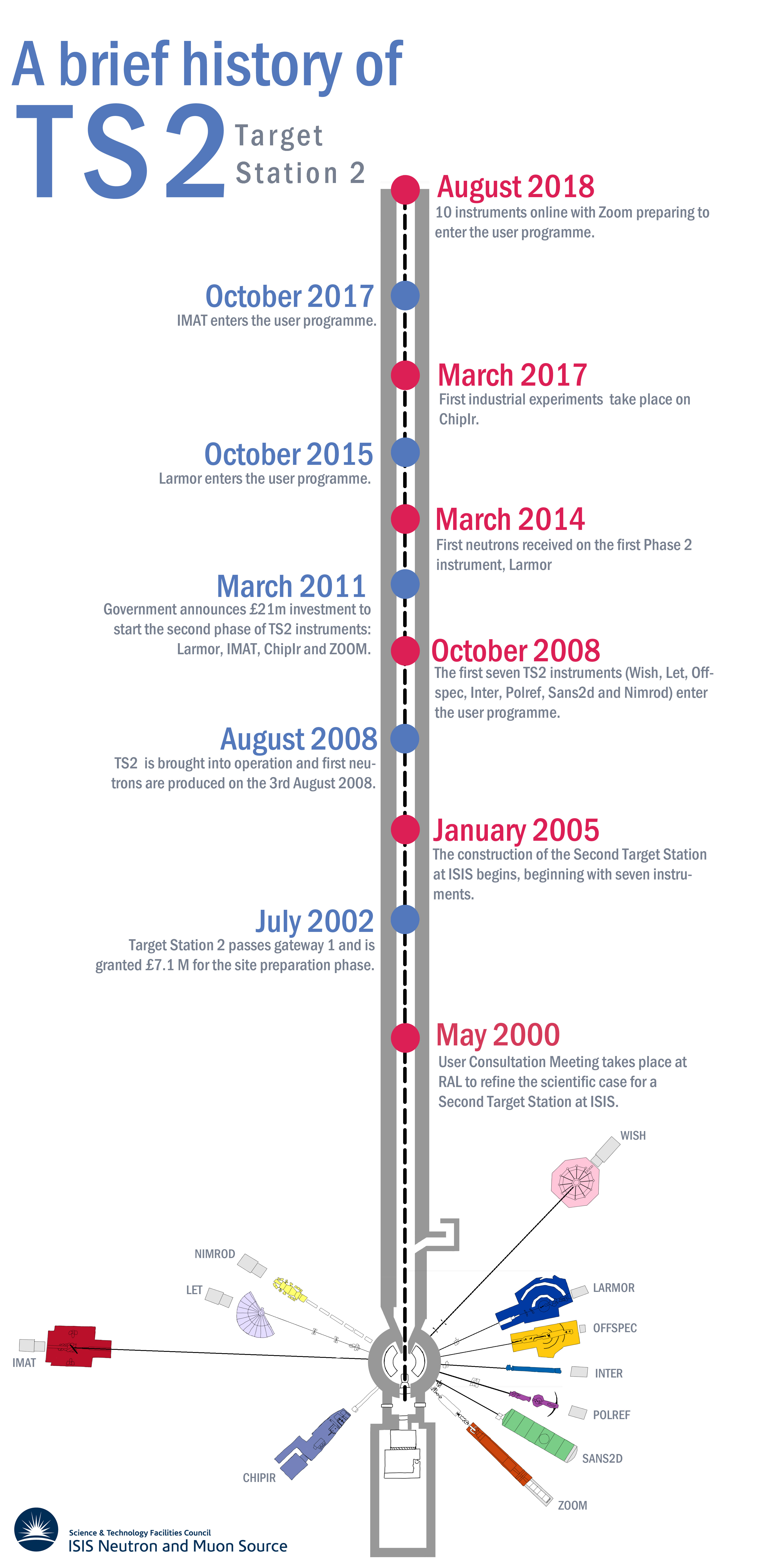INTER was the first instrument to be completed as part of the Second Target Station project.With a budget of £145 million, Target Station 2 (TS2) was built with the purpose of increasing the capabilities and capacity of ISIS Neutron and Muon Source.
The decision that ISIS was to expand was announced back in April 2003 by the then Science Minister, Lord Sainsbury. Starting with the commissioning of seven instruments, the second phase of the project would increase the TS2 instrument number to eleven.
Built with the intention of expanding our research capabilities in the areas of soft matter, advanced materials and bio-science, the Second Target Station has gone on to surpass expectations. In 2018, ISIS has two target stations, 32 instruments and welcomes an international community of over 2000 scientists every year. From Physics to Chemistry, Earth Sciences to Life Sciences, the research that takes place within its walls is ground-breaking. Day and night its incredible team of scientists and engineers work non-stop to ensure that experiments run smoothly and that we get the best possible results we can, which is why we are cited in well over 400 journal articles a year.
In this special anniversary feature, we look at some of the ways that TS2 research over the past decade has been used to tackle some of the greatest challenges of the 21st century.
Healthcare
One of the initial aims of TS2 was to allow for new areas of research to flourish, particularly within the fields of soft matter and bioscience. Over the past ten years, scientists from all over the world have been coming to use the neutrons produced at TS2 to study the structure and dynamics of complex biological systems for a plethora of healthcare applications. Back in 2015, researchers at the ISIS Neutron and Muon Source and Newcastle University made news for the creation of the first working model of the outer membrane of the bacterium Escherichia coli (E.coli). The synthetic model constructed at ISIS and studied using POLREF will serve as a robust system and important tool in drug design, particularly for the development of new antibiotics.
This year, using the same model, the team (pictured below) came back to ISIS to examine how Polymyxin B, a last resort antibiotic, interacts with the outer membrane of Gram-negative bacteria. Using INTER, the team not only revealed the temperature dependence of Polymyxin B function, but also presented evidence to support the notion that bacteria such as E.coli actively control the viscosity of their outer membrane as temperatures vary. The results of this study, published in the prestigious PNAS journal, provide powerful insight into the resistance of bacteria responsible for many life-threatening diseases such as pneumonia and meningitis.
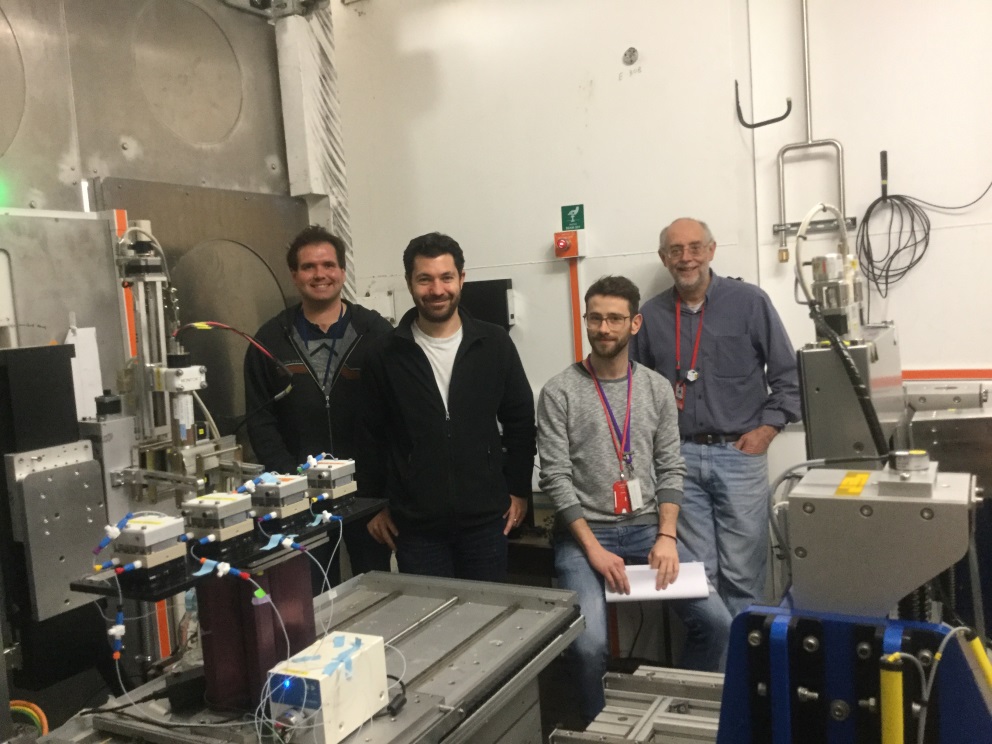
Scientists Luke Clifton, Maximilian Skoda, Nicolo Paracini and Jeremy Lakey beside POLREF. (Credit: STFC)
An early experiment using the OFFSPEC instrument in 2010 focused on improving treatment for babies born with cleft palates, the most common craniofacial birth defect in the UK. Using the expertise of this advanced reflectometer, the team led by the University of Oxford and John Radcliffe Hospital, investigated hydrogels on the molecular level to try and collate enough information so that materials can be developed for use as potential new treatments.
TS2 instruments have also been used in the fight against cancer, the second leading cause of death globally. Back in January of this year, research completed using our SANS2D instrument put forward the idea that selective kinds of drug-bearing nanotubes, like cyclic peptide-polymers, can be used in anti-cancer therapy. SANS2D was used because it can examine the size, shape, internal structure and spatial arrangement within nanomaterials on length scales between 0.25 and 300nm. The capabilities of SANS2D are ideal for studying the self-assembly of cyclic peptide-polymers and confirming their characteristic cylindrical shape. This knowledge can then be used to design anti-cancer drugs that act as 'magic bullets', directly targeting mutated cells.
In 2013, scientists from Birbeck College, London used neutron reflection on our INTER instrument to study the process by which ozone in our atmosphere attacks surfactant molecules in our lungs, often exacerbating asthmatic symptoms. Results from their studies have provided insight into the production of new inhalers for asthma and cystic fibrosis sufferers, along with aiding premature babies born with low levels of lung surfactant.
Heritage Studies
The TS2 instruments at the ISIS Neutron and Muon Source have not just been used to look forward; they have also been used to uncover the secrets of our past. Over the last decade, TS2 has allowed scientists to use cutting-edge modern neutron techniques to study ancient artefacts.
For example, in 2018, scientists from Centro Fermi in Italy used the TS2 instrument, IMAT, to non-invasively investigate the content of two artefacts from the tomb of 'Kha and Merit', a married couple who walked the streets of Ancient Egypt over 3000 years ago. IMAT (Imaging and MATerials). Thanks to the non-invasive property of neutrons, the team could determine the content of two sealed vases without having to break into them, which would have been very damaging. Their data not only provided details of the inner morphology, structure and elemental composition of both vases from Kha and Merit's grave, but also helped shed light on the mystery of the Seven Sacred Oils of Ancient Egypt.
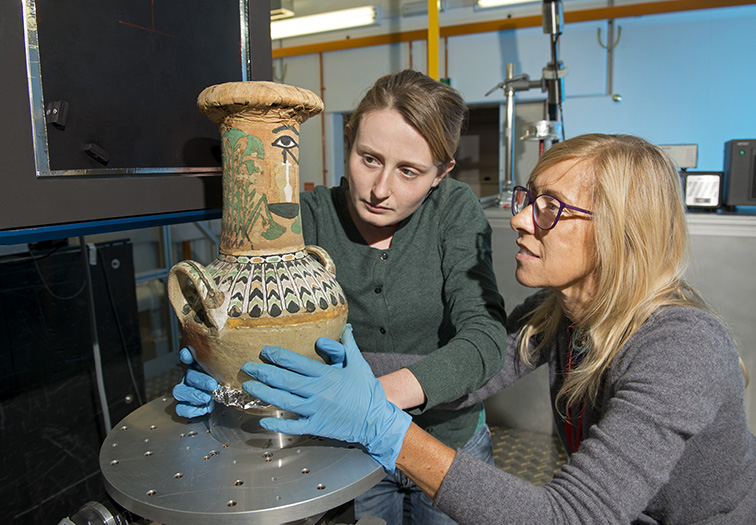
Matilde Borla, Soprintendenza Archeologia Piemonte, and Valentina Turina, Musco Egizio di Torino, adjusting an Egyptian vase mounted on the IMAT instrument at ISIS Neutron & Muon Source (credit: STFC).
Two years earlier, IMAT demonstrated just how neutron studies can help us to uncover the secrets of our musical heritage. In one of its first experiments, scientists used IMAT to study an Amati violin, exploring how the millimetre thick wood was used to construct the famous violins, and how small details of the instrument's shape influence sound production.
Transport
In 2011, ISIS launched the second phase of the TS2 expansion project (phase II) to increase the total instrument number from seven to eleven. As part of this second-phase instrument suite, ChipIr was built to facilitate fast neutron testing for the semiconductor industry and has recently started its commercial programme. One of the applications of such state-of-the-art technology is within the transport sector, most notably for the safe testing of aircraft and automobile electronics.
This year, scientists from the Federal University of Rio Grande do Sul (UFRGS) in Brazil have been using ChipIr to test whether off-the-shelf electronics meet the strict standards required for use in the automotive industry. One of these standards relates to environmental change, more specifically change which comes from outer space, called cosmic neutron radiation.
Cosmic rays are a natural form of radiation. When they hit the Earth's atmosphere they generate small particles called neutrons or muons. These particles are so tiny that they are capable of passing through most objects, including humans, with no repercussions. Whilst they are harmless to us, the same cannot be said for semiconductors found within electronic devices, including ones found within driverless cars. The most prominent example of this is for self-driving cars that are reliant on GPUs (Graphic Processing Units).
Having started its commissioning in 2017, ChipIr is a unique beamline dedicated solely to the irradiation of microelectronics with atmospheric-like neutrons. The intensity of the neutron beam means devices would receive an exposure equivalent to thousands of years of use in a single hour on Earth.
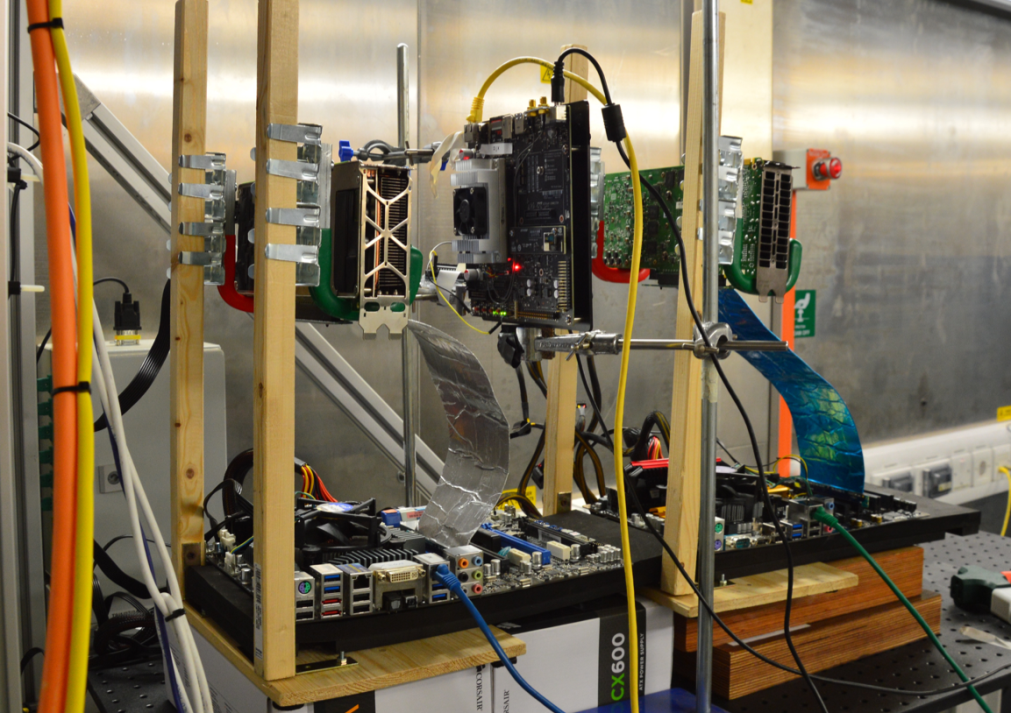
Irradiating microelectronics with neutrons from ChipIr (Credit: Paolo Rech, UFRGS)
Energy
As the world population grows exponentially, so does the amount of energy needed to fuel our cars and heat our homes. TS2 research has helped to develop new technologies to meet the rising demand for clean, green energy.
Back in 2011, for example, scientists from the University of Sheffield used neutron reflectivity on LARMOR, to provide important insights into how ultra-cheap solar energy panels can be manufactured on a large scale, for both domestic and industrial use. LARMOR helped them discover that nanoscale solar cell films could be manufactured using high-volume printing, a much cheaper and simpler option than using current fabrication methods.
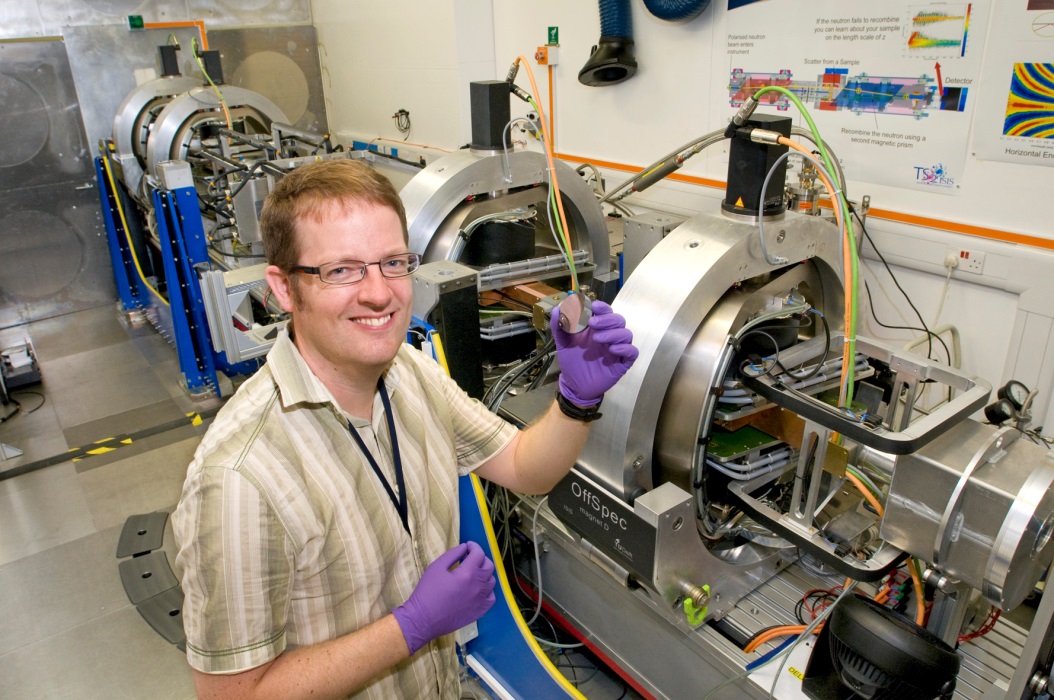
Robert Dalgliesh holding a polymer solar-cell sample beside LARMOR. (Credit: STFC)
In the bid to cut down on carbon emissions, seven of the UK's nuclear power stations have Advanced Gas-cooled Reactors, operated by EDF energy. These coolers help generate low carbon electricity. The only problem is, over time, the graphite shielding within them slowly loses weight through normal ageing processes, a phenomenon that can determine the operational lifetime of the power station. Scientists from the Open University and EDF Energy came to use SANS2D in 2018 to gain a greater understanding of how cracks propagate in the graphite shielding. They are hopeful that this information will be used to improve how welds are assessed in these safety critical systems and determine whether reactor lifetimes can be extended. With this knowledge in mind, energy companies like EDF can ensure that the UK will be provided with secure and reliable low-carbon electricity for a long time to come.
Fossil fuel combustion releases harmful pollutants like carbon dioxide into our atmosphere, and extraction from the source often causes great environmental damage. Not only that, fossil fuels are in short supply. One popular solution at the moment is the potential of Hydrogen, the so-called 'Hydrogen economy'. There are many benefits of using hydrogen as a fuel; it is clean – only producing water vapour and heat as combustion by-products – and there is, at least in theory, an unlimited supply. However the flammability of hydrogen is a double-edged sword; it provides us with ample energy to run our vehicles but it also has the ability to cause an explosion as hydrogen reacts fiercely with the oxygen in the air. To solve this dilemma, researchers from Delft University of Technology and Catholic University of Leuven used OFFSPEC to help develop an extremely sensitive hydrogen detector capable of detecting gas leaks. These 'optical hydrogen sensors' absorb hydrogen which alters their reflectivity, and it is this change in reflectivity that can determine the concentration of hydrogen in a specific location. This research will help ensure the quality and safety of hydrogen sensors, taking us one step closer towards a hydrogen economy.
So what is next for TS2? Over the past year, all four phase II neutron instruments (CHIPIR, IMAT, LARMOR and ZOOM) have continued to make significant progress into and towards their user programmes. There are also plans to extend TS2 further in order to ensure that the ISIS Neutron and Muon Source maintains its international competitiveness.
Of course, research completed using TS2 instruments features in hundreds of journal articles a year, only a tiny selection of which has been mentioned in this article. If you'd like to find out more about the incredible research that takes place at both TS2 and TS1 then look no further than the Science Highlights page on the ISIS Neutron and Muon Source website.
We look forward to seeing what cutting-edge science comes out of the next 10 years and beyond.
Further information
For more information on the variety of science that takes place at ISIS Neutron and Muon Source browse all our science highlights here.
An infographic timeline of Target Station 2 can be found here and below.
An infographic on the instruments in Target Station 2 East and West can be found on these links and below.
